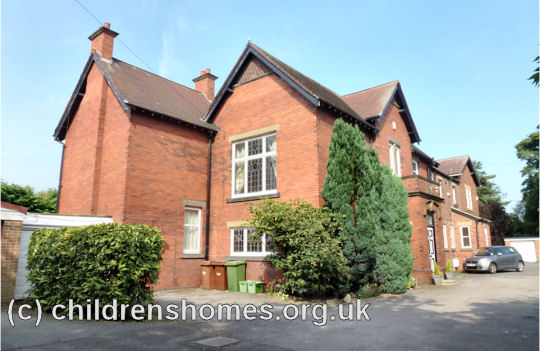Wakefield Council Homes
In 1930, following the abolition of the Wakefield Poor Law Union, the Wakefield Corporation took over responsibility for the administration of poor relief in the city. Unusually, the council's new Public Assistance Committee did not inherit any of the union's children's homes, which all passed into the control of the West Riding County Council. However, Wakefield had an agreement with the county council for use of the homes.
The first children's home to be directly run by Wakefield Council appears to have been Flanshaw Lodge, 192 Flanshaw Lane, which was opened in around 1946. It had fifteen places, with Miss L.E. Frederick as superintendent.

Flanshaw Lodge, Wakefield. © Peter Higginbotham
Following the passing of the 1948 Children Act, councils were required to provide care services for all needy children in their area, especially those who lacked a normal family home. In common with other local authorities, the council established a new Children's Committee, whose responsibilities had previously been spread across separate Health, Education and Social Welfare Committees. Under the new regime, residential care was seen as the least desirable option for children in care, but when it was employed, the recommended size of home was eight children, or twelve at most.
It was not until 1957, however, that the council opened its second children's home, the Kettlethorpe family group home at 123 Kettlethorpe Road, Wakefield, with Mrs M.E. Vaux as what was termed its foster mother.
By 1968, two further family group homes had been opened — the Wasdale Home at 70 Wasdale Road, Flanshaw, and the Dacre Home at 9 Dacre Avenue, Lupset.
In 1968, the Flanshaw Lodge home was taken over by the Church of England Children's Society and became known as Flynn House.
In 1971, local authority children's departments were absorbed into their new social services departments. Following the local government reorganisation that took place in 1974, the new Wakefield Metropolitan District Council took over several homes that had previously been run by the West Yorkshire County Council.
The council's children's establishments in operation in 1975 are listed below.
| Nurseries | |
|---|---|
| Location | Places |
| 4 Cromwell Drive, Sprotborough | 10 |
| 69 Pinewood Avenue, Armthorpe | 10 |
| 14 Morrison Drive, Rossington | 10 |
| 41 Stonehill Rise, Scawthorpe | 8 |
| 85 Shaftesbury Avenue, Woodlands | 8 |
| Wyndthorpe Hall, Dunsville | 24 |
By 1984, however, more than half of these homes had closed, while three new establishments had been opened. Those then in operation comprised:
| Location |
| 123 Kettlethorpe Road |
| 9 Dacre Avenue, Lupset |
| 2 Ings Road, Kinsley |
| 13A Marton Avenue |
| Flanshaw Children's Centre, Springfield Grange |
| 50 Horbury Road, Ossett |
| 51 West Mead, Castleford |
Children's establishments run at some time in their history by Wakefield Council.
- Eastwell Lodge, Moor Lane, Carleton†
- 51 West Mead, Castleford
- 13A Marton Avenue, Hemsworth†
- 17 Highfield Place, Hemsworth†
- 2 Ings Road, Kinsley†
- 50 Horbury Road, Ossett
- Kettlethorpe Family Group Home, 123 Kettlethorpe Road, Wakefield
- Flanshaw Lodge, 192 Flanshaw Lane, Wakefield
- 29 Peterson Road, Wakefield
- Sandal Hall, 335 Barnsley Road, Wakefield†
- Hostel, 37 Bradford Road, Wakefield
- Flanshaw Children's Centre, 6 Springfield Grange, Wakefield
- Wasdale Family Group Home, 70 Wasdale Road, Flanshaw, Wakefield
- Dacre Family Group Home, 9 Dacre Avenue, Lupset, Wakefield
- St John's Home Training School, St John's Square, Wakefield
- Hostel, Stoneville, 112 Lower York St, Wakefield
- Sandal Residential Nursery, Walton Lane, Wakefield
† indicates homes at some time also run by a county council.
Records
The involvement of local authorities in the running of children's homes dates from 1930, when they took over the running of the poor relief system previously administered by Boards of Guardians. Surviving records for council-run children's homes may be held in each council's own internal archives. Prior to 1991, however, when a legal requirement was introduced for councils to retain records of children leaving their care, the survival of such records is very variable. Contact details for local authorities in the UK can be found on the website of the Care Leavers Association (CLA). The CLA also provides guidance on accessing childhood care files, which are normally only open to the individuals they relate to.
Locating local authority records has been complicated by the various local government reorganizations that have taken place in recent times, such as the abolition of the London County Council in 1965, and the major nationwide restructuring in 1974 in which many administrative areas were created, amended or eliminated.
Older records may sometimes be placed with the relevant county or borough record office. Many of these repositories have online catalogues of their holdings and also contribute to the National Archives' Discovery database. Note that records containing personal data usually have access closed for a period of fifty years or more.
Older material relating to Wakefield Council homes may exist at:
- West Yorkshire Archive Service (Wakefield Office), West Yorkshire History Centre, 127 Kirkgate, Wakefield WF1 1JG.
Some records relating to council-run homes, for example inspection reports (though not resident lists etc.), are held by The National Archives (TNA). A closure period may apply to these records.
Bibliography
- Higginbotham, Peter Children's Homes: A History of Institutional Care for Britain's Young (2017, Pen & Sword)
- Urquhart, Gloria (2020) Nobody's Child: The True Story of Growing up in a Yorkshire Children's Home
- Cooke, Allan Institutionalized in a Children's Home: Skellow Hall 1950-1963 — a true story of a child and children in a home (2012, Authorhouse)
- Cummings, Les Forgotten: The Heartrending Story of Life in a Children's Home
- Limbrick, Gudrun The Children of the Homes: a century of Erdington Cottage Homes
Except where indicated, this page () © Peter Higginbotham. Contents may not be reproduced without permission.


